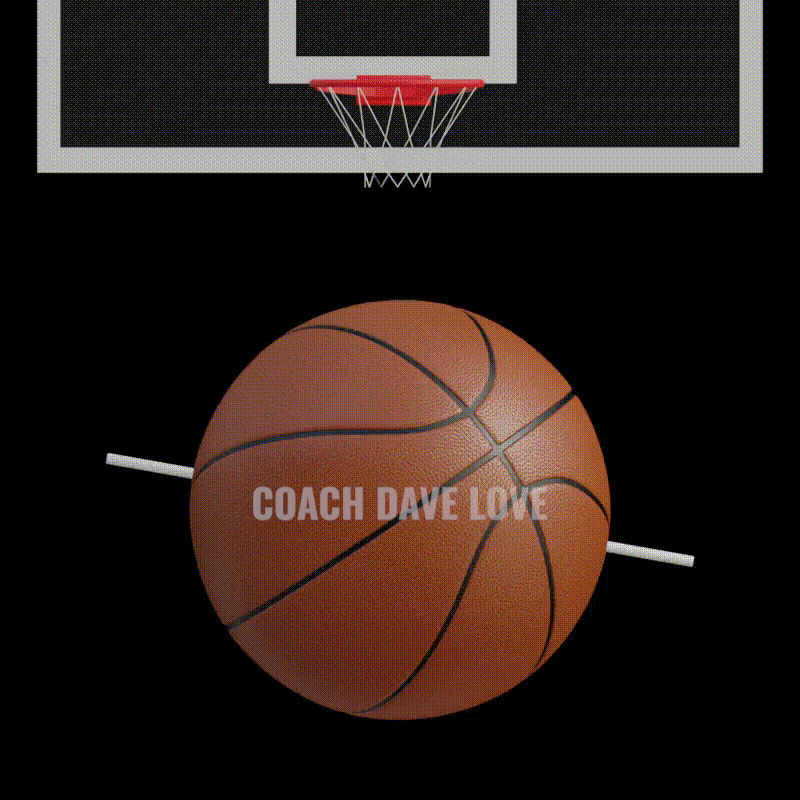To understand shooting mechanics, particularly how the ball is released from the hand, we must understand the illusion and the reality of ball spin. The quantification and measurement of this idea led to the creation of ShotMetrics, and gives valuable information about how the ball leaves a player’s hand, and how consistently the player repeats this movement. Unfortunately, because the challenges in measuring the spin of the ball have been so great there has been a fundamental lack of understanding of how the ball spins and what it means. I hope to shed some light on this important concept in this blog.
The Optical Illusion
The greatest challenge in understanding the information that can be gained from the spin of the ball is the illusion created by the seams of the ball. In the graphic to the right we see a ball spinning perfectly on the X axis, with no eY or eZ tilt, and the seams aligned with the axis of rotation. This is what many coaches envision when they think of a player having “good” or “pure” rotation, and in this case they would be correct in that assessment.

Perfect 1.000 eX. 0.0000 eY, 0.0000 eZ rotation with the seams aligned with the axis of rotation.

Perfect 1.000 eX. 0.0000 eY, 0.0000 eZ rotation but with the seams unaligned with the axis of rotation.
But this ball also has completely pure rotation with the ball also spinning fully around the X axis with no eY or eZ tilt. It is just that the seams of the ball aren’t aligned with the axis of rotation, and because of that it is much harder to see the pure rotation of the ball with the naked eye. Most coaches would incorrectly say that this player doesn’t have pure rotation because the coach has a fundamental misunderstanding of the role of the seams. The ball is rotating purely, it’s just that the seams aren’t aligned with the axis of rotation.
The seams of the ball play little role in the players ability to shoot the ball beyond their comfort of the grip on the seams of the ball. The orientation of the seams does not effect the flight of the ball as significantly as it would it baseball, where spin rates are significantly higher. The pure rotation of the ball with the seams unaligned gives the player just as good of chance of the ball going in it would if the seams were aligned. Unfortunately most coaches know that they don’t like impure rotation of the ball, but don’t understand why they don’t like it, AND can’t accurately measure in what way the ball is actually spinning.
A DEEPER UNDERSTANDING
Things get more challenging when the ball begins to spin off axis. Here, the ball has a slight downward tilt (-eY) to the axis of rotation on the right side of the ball. But if it weren’t for the animation of the axis of rotation, most coaches likely wouldn’t be able to see that there was any change in the way the ball is spinning when comparing this shot and the shot with pure rotation but the seams not aligned. There was a slight change in the way the ball was released but it would likely go undetected.

10 degree -eY tilt to the axis of rotation, seams unaligned.
Whereas if the seams are aligned we can see that there is a slight tilt to the ball, but this would only be visible if the player began with their hand on the middle of the panel (the space between the seams) and perpendicular to the seams. Had they not begun with their hand in the middle of the panel, there could appear to be this kind of tilt in the axis of rotation even if the ball was spinning purely on the X axis. The trouble is, most coaches would say this player has pure rotation because there is only a slight tilt to the axis and the seams create an aesthetically pleasing (though impure) spin.

10 degree -eY tilt to the axis of rotation, seams aligned.

10 degree -eZ tilt to the axis of rotation, seams aligned.
This is where things get really challenging. This ball is spinning the same amount off axis as the previous shot, but this time with a forward tilt on the right side instead of a downward tilt. That subtle change can be just as detrimental to a shooter, but is nearly impossible to see even with an informed eye. While this amount of tilt usually doesn’t cause a player to struggle with shooting the ball, it illustrates the challenges in trying to use this potentially valuable information to coach based on the eye test.
To make use of this information, coaches will need to understand that different types of spin are caused by different hand movements on the ball. The more the hand makes a move that would potentially push the ball off line, the more the ball will spin off axis. Measuring how the ball is spinning (read the blog on Release Quality) is an effective way to quantify how effectively a player pushed the middle of the ball along the target line, which is also the best way to get the ball to travel in that direction.
A Step further
This is an example of a ball that is spinning significally off axis. With the seams aligned, it is easy to tell the ball is spinning off axis, but most players don’t have the luxury of gripping the ball perfectly on each shot. More importantly, take a moment and figure out how you would need to release the ball in order to make it spin this way. I think you’ll agree, whatever release you came up with would make it difficult to keep the ball on line with the target as you shot it.

45 degree -eY tilt to the axis of rotation, seams aligned.
And to further complicate the problem, this is what the same axis of rotation looks like with the seams unaligned. I can almost guarantee that if you saw this ball spinning in the air (remember, you only get about 1.5 seconds of the ball in the air) you wouldn’t be able to tell in what way the ball was spinning. And if you’d seen the last two balls shot back to back, there is no way you would know that they had the exact same axis of rotation.

45 degree -eY tilt to the axis of rotation, seams unaligned.

45 degree -eY -eZ tilt to the axis of rotation, seams aligned.
If the seams were aligned, would you be able to tell that this ball had a completely different axis of rotation (now there is a downward AND forward tilt in the axis) again? Likely not. There is an immense amount of information that can be gained from the axis of rotation about how the player pushed the ball, and studying it for several years now has revealed the amount of misunderstanding amongst coaches about the spin, its importance, and the moves that create it. This concept is a representation of how the shooter’s hand pushed the ball, but it has been misunderstood and ignored for years.
If you’ve played any golf, you’ve probably sliced a ball. The ball that sliced was spinning with such impure rotation and at such a rate that it curved in the air. Most basketball coaches wouldn’t understand the parallel because they would say that a basketball barely curves in the air. But they are missing the point. The slicing of the ball tells an educated golfer that their club face was open and the swung outside/in across the target line. The result indicated the spin, which then indicates where the club face was at impact and how it moved.
The same could happen in basketball, we just won’t see the initial indicator in the flight of the ball. But when we measure the spin of the ball we get an indicator of how their hand pushed the ball. When I began my ShotMetrics journey, I initially intended to study how the fingers pushed the ball, but was told repeatedly by various companies that the fingers were too small to be measured accurately. But measuring the ball gave important cues as to where the hand must have been.
HAVING COACHED WITH THIS INFORMATION
I’ve been coaching with this data since beginning my research on the topic in 2021. In that time I’ve gained a deep understanding of the spin of the ball, and the moves that cause pure and impure rotation. I’ve seen great shooters with pure rotation and been able to see how they grip the ball and how it releases from their hands. I’ve seen poor shooters with very off axis rotation and been able to determine what kinds of hand movements cause what kinds of spin, and why they are detrimental. I’ve seen great shooters with above average spin but incredibly consistent releases, and weak shooters with pure rotation but inconsistent at repeating it. I’ve seen how adjusting the positioning of the feet can affect the axis of rotation, and I’ve seen how coaching interventions have improved shooters. All this information has led to an incredible wealth of information, while most coaches have been giving advice based on their opinions of an optical illusion. Players deserve better than that.
In 5 years there will be more ways than just the software we created to help us quantify the spin, and along with that will be a deeper understanding of how the ball is released from a players hand, and the habits that we should be guiding players towards. A generation beyond that there will be players that grew up with this understanding. It will be amazing to see what can be done in shooting development in that time.



